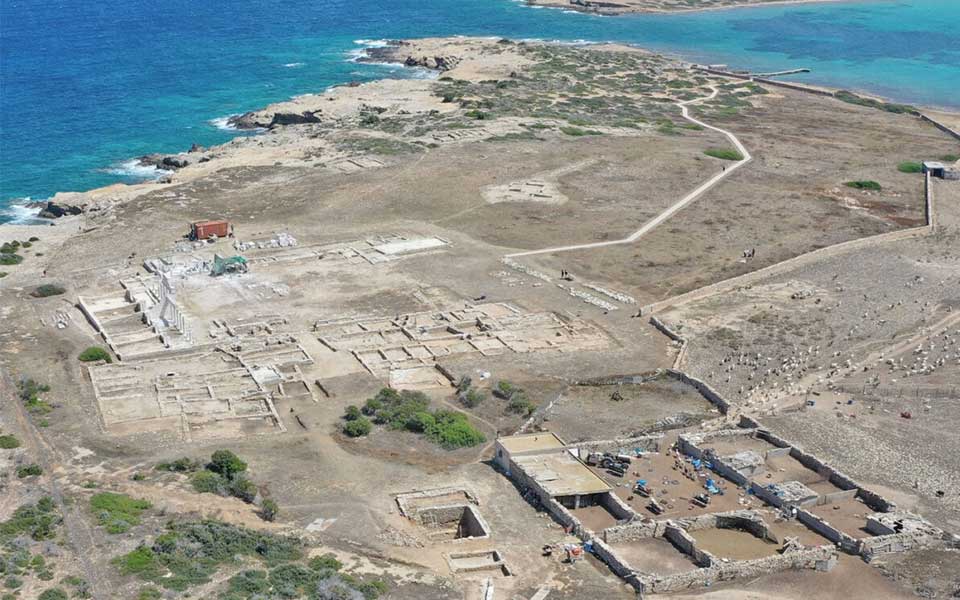Archaeologist Giannos Kouragios has been conducting research on Despotiko, also known as the Island of Kouroi since 1997. Even he, who began his work on this uninhabited virgin island southwest of Antiparos, first with rescue excavations and then systematic ones from 2002, is astonished when attempting a quick assessment of the treasures that have come to light over the years. Along with this year’s findings, he counts eleven kouros heads, two complete kouros statues, another one in three parts, and more than 110 fragments of upper and lower extremities, torsos, and other body parts. Furthermore, there are 40 bases for statues and dedications, at least 500 inscribed ostraka (pottery shards, both dedicatory and voting tokens) indicating the worship of Apollo, and a single head of a kore (female figure), as well as 32 buildings, including those on the neighboring island of Tsimintiri, which was connected to Despotiko by a strip of land in Archaic times.
“I have never seen anything like it,” he says to Kathimerini newspaper. “Every year, I think we are reaching the end of the excavation, but the new findings prove us wrong. The excavation of Despotiko seems inexhaustible, continually providing new information about its topography and its history from the early Iron Age.”
The inhabitants of ancient Paros strategically established the renowned and prosperous Archaic sanctuary of Apollo, aiming to solidify their dominance in the Aegean. It is a sheltered site in the center of the Cyclades, where travelers from neighboring islands, as well as from Asia Minor, Egypt, Cyprus, and Phoenicia, would arrive. However, as glorious as this place was (it thrived in the 6th century BC), it was destroyed by bloodthirsty pirates in late Medieval times.
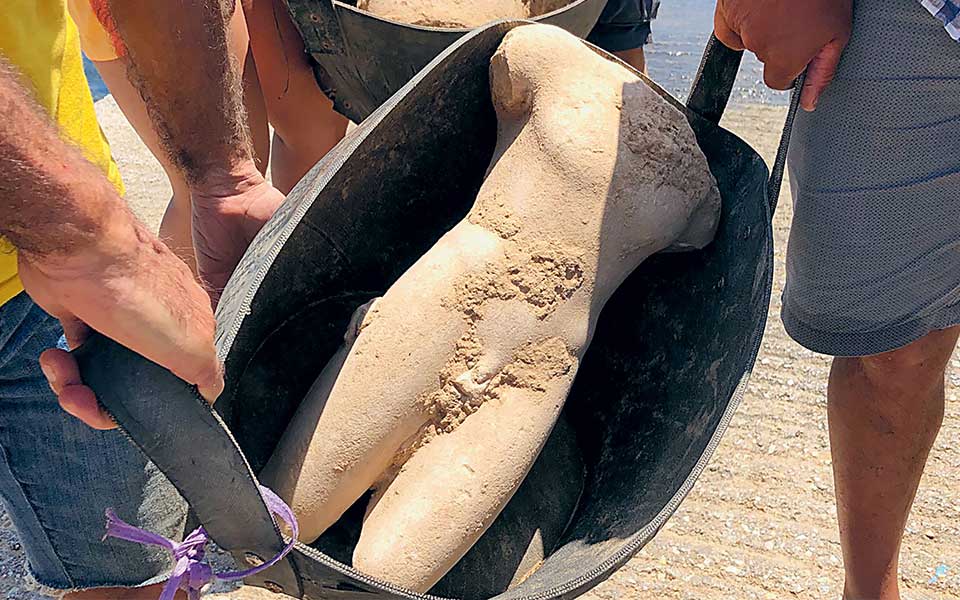
© The Hellenic Ministry of Culture
This year’s top discovery is the headless torso of a kouros, in the severe style, found at a depth of 50 centimeters. Sculpted in the famed Parian marble, with a smooth and glossy surface bearing characteristics reminiscent of the ‘Kritios Boy’ housed in the Acropolis Museum, the artifact is dated to after 480 BC. It was discovered in a significant, large structure on the verge of collapse, possibly fortified, perhaps a gatehouse or a retaining wall, says the archaeologist of the Ephorate of Antiquities of the Cyclades. Mr. Kouragios explains that this structure, defined by two walls constructed with large schist stones, was identified four years ago. The headless male torso found this year is now housed in the Archaeological Museum of Paros, and it preserves the imprint of fingers on the thigh, “while the other hand seems to have been raised, a gesture toward the deity.”
Many more fragments of Archaic kouroi were identified at the same location, which had been incorporated as building materials. Among them was a portion of another headless kouros dating to the second half of the 6th century BC. Specifically, the upper and lower torso of the statue were found, and nearby, the back of the head was discovered, preserving a portion of the locks of the kouros’ long hair. According to the experts, a segment of the upper torso of a statue is also missing, possibly related to a finding from another part of this sturdy structure or propylon. A portion of the lower body (from the abdominal area to the thighs) of another kouros and a fragment of a leg and hand were also found here this year, within a wall built at a later date. Last year, precisely at the same spot, two more large fragments of lower extremities from other kouroi, marble bases of dedicatory columns, and a seated female statue were unearthed.
Giannos Kouragios emphasizes that the kouroi had different characteristics, depending on their origin. “Kouroi from Asia Minor had long hair, those from Athens had shorter hair, and those from Naxos were more robust. The Parian sculpture was more advanced.”
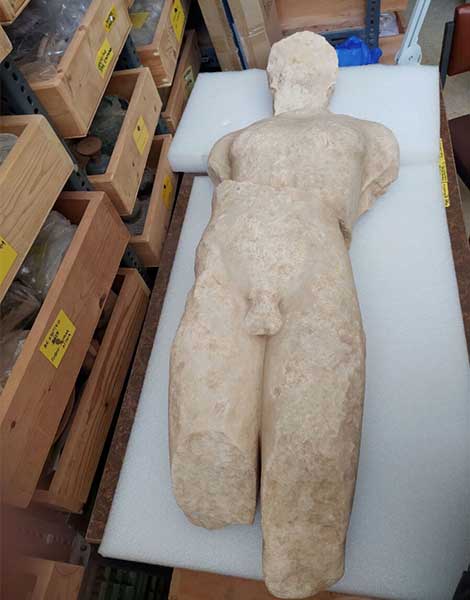
© The Hellenic Ministry of Culture
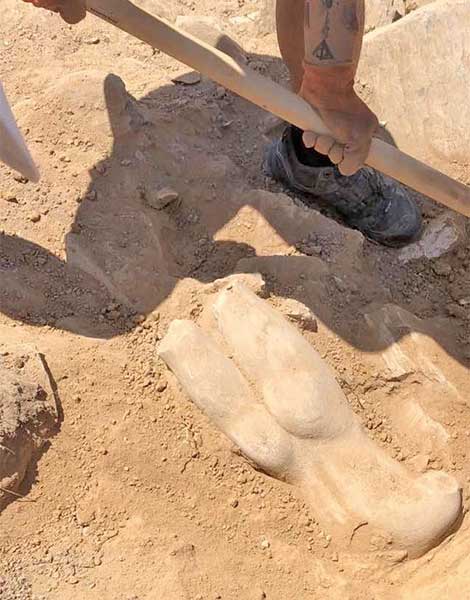
© The Hellenic Ministry of Culture
Why were kouroi and fragments found at the same location? “As the faithful visitors of that time ascended towards the entrance of the sanctuary, and at least 500 meters before reaching the temple peribolos (court enclosed by a wall), they admired the dedications placed on pedestals dedicated to the god Apollo on the propylon,” explains the excavator. He adds that during Medieval times, when the Archaic building was demolished, all this wealth of votive offerings was used as building material for other structures.
For Giannos Kouragios and the other archaeologists collaborating on the excavation, namely Alexandra Alexandridou (Associate Professor at the University of Ioannina) and Ilias Daifas (University of Thessaly), particular significance lies in the complex and well-organized water management system that was discovered in 2019, and continues to be revealed. In fact, following the impressive rectangular stone construction, which features four holes arranged in two horizontal rows to control the water flow from the reservoir to the conduit, a Byzantine reservoir was also discovered. Spaces where water filtration took place were revealed nearby, along with a stone conduit measuring 25 meters in length, originating from another large, oval-shaped reservoir. This year, in a section that had collapsed, a natural rock functioning as the bottom of the reservoir was exposed. A small fragment of a clay base of a perirrhanterion (water basin) with a relief representation of a lion, dating back to the 6th century BC, stood out among the findings. “This year, we completed the restoration of the water supply and storage system in the large Archaic reservoir.”
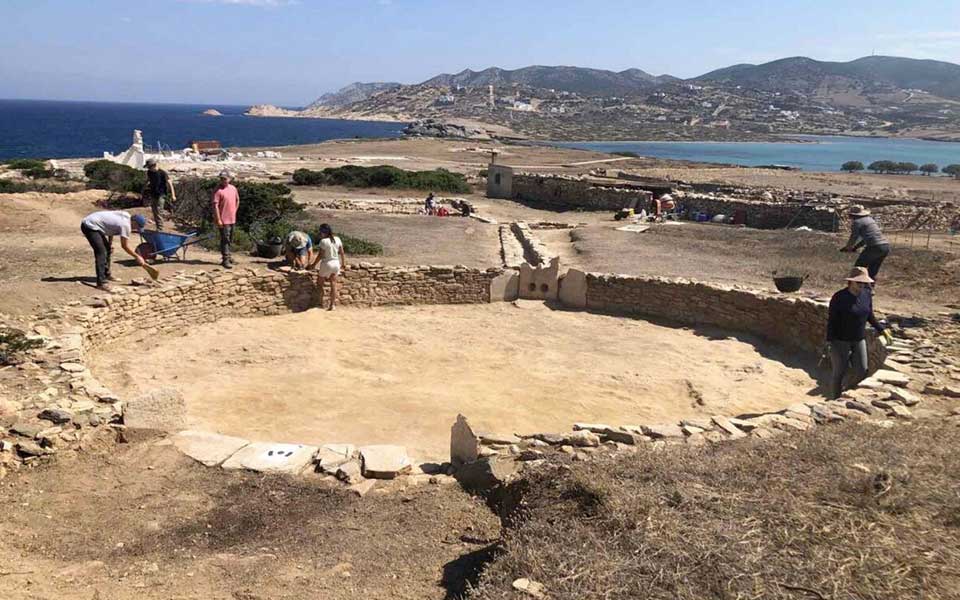
© The Hellenic Ministry of Culture
The buildings
The highlights of this year’s findings include a large column base and a circular structure, which might correspond to the large kouros recently discovered, as well as a large Archaic building. “Contrary to the view that the buildings found belong to a settlement, I believe they served as auxiliary structures for the large sanctuary. Perhaps lodgings for visitors, priests’ quarters, guard stations, as well as storage areas. We don’t have any streets, but rather large buildings with parallel rooms. I believe these were structures for the operation of the sanctuary,” explains the excavator. He acknowledges that a settlement might have begun during the Geometric period, which later evolved into a large sanctuary. He claims that the city of Paros invested a lot of money in the foundations, the buildings, the ceremonial restaurant, the temple, the peribolos, and of course, in transporting the famous Parian marble to Despotiko. “The construction of the sanctuary required a substantial budget. This could not be undertaken by any city state, but rather by a powerful one with significant resources that wanted to establish its dominance in the Aegean. The hydraulic works were extensive and served to collect water for the replenishment of ships. This was a major naval station. Water was required for ships undertaking long voyages, which had to be resupplied or protected from strong winds. Such sanctuaries served these purposes. The Temple of Apollo Zoster in Vouliagmeni is a similar case.”
Three cooking vessels were among the mobile findings, as well as pots embedded in the walls and one of them on the floor. Additionally, a lamp with a thick handle, a sime (roofing tile) from the building’s roof, clay acroteria in the form of a gorgoneion and dedicatory offerings with the initials of the god Apollo made by the faithful were also discovered. The distinctive marks suggest they were written by the same hand.
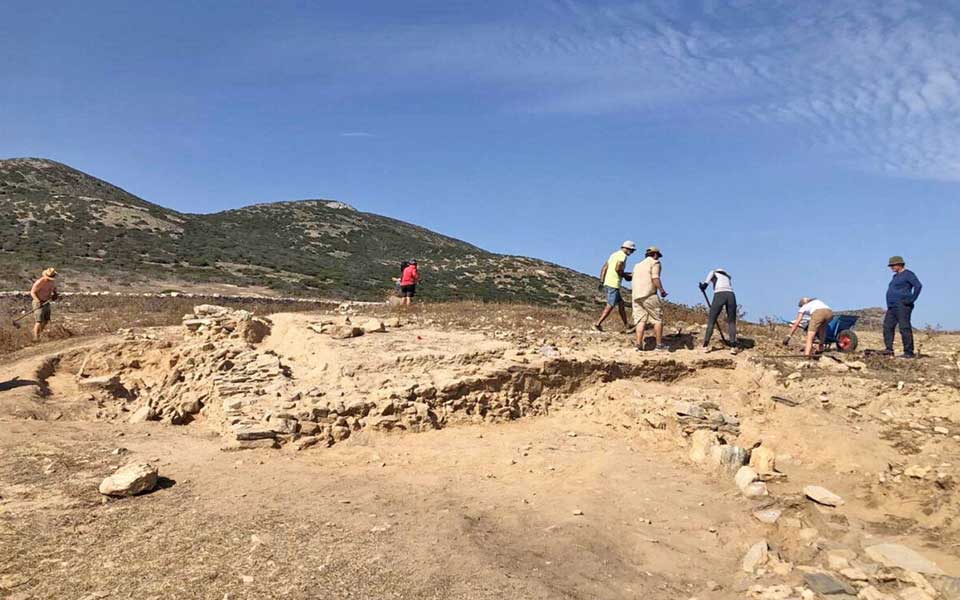
© The Hellenic Ministry of Culture
Three dimensions
Those traveling by ferry in the Aegean can admire the monument and its newly added third dimension from afar, through the re-erection of the temple’s columns under the supervision of the architect Guglielmo Orestidis. “We want future visitors of the archaeological site to understand what this sanctuary was. I don’t share the old view of my colleagues who didn’t want monuments to be raised. My role model is Petros Themelis and what he achieved in Messini. We raise monuments so that the public can comprehend them,” says G. Kouragios. Work will continue in the fall to complete Building D.
What else does he expect, after the recent findings? “Despotiko is a rich archaeological site. In one day, we unearthed two kouroi. It’s not an easy process. It requires careful work with the small sticks they use for souvlaki to remove stones and soil, and a small broom to clean and separate. It took five hours of meticulous labor. The marble surface is sensitive, and the entire process resembles a surgical procedure,” says the excavator of Despotiko.
Unexpected visitors
However, he expresses one complaint. “What made it difficult for us this year was the sudden influx of visitors brought to Despotiko by various people for a fee, using inflatable boats and vessels. They see the reconstructed temple from afar and disembark on the uninhabited islet. They insist on entering the excavation site, even though it is prohibited. They want to take photos of themselves in their swimsuits on the ancient ruins, showing no respect for the space, and even verbally abusing us when we tell them it is not yet organized or open to the public. These are different and unprecedented behaviors,” he says.
The excavation and restoration works were carried out with the support of the Kanellopoulos, Leventis, Latsis, and Marion Stassinopoulos Foundations, as well as the AEGEAS Non Profit Civil Company – Athanasios and Marina Martinou and the association “Friends of Paros”, among others.
This article was previously published in Greek at kathimerini.gr.

